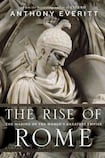
A t the start of his new book on the history of Rome, from its foundations to the late republic, Anthony Everitt contrasts the great first-century historian Livy with the academic historians of the present. Where contemporary historians tend to be too sceptical about the more bizarre incidents that are handed down to us, Livy uses artistic licence to describe events as they may have happened.
In his preface, Livy urbanely suspends judgment about whether the stories he is about to tell us of Rome’s beginnings are true. As he puts it, if Romans want to say that Romulus, their founder, was the son of the god of war, the conquered peoples of the world are in no position to argue with them.
For Livy, there’s a question mark over how much one can know about the distant past, but the traditional stories of what happened preserve a sort of symbolic truth that speaks to Romans about who they are and how they should act in the present. Where Livy is more upfront than Everitt is in his acknowledgment that the politics of his own time have an impact on what can be said about the past and what it means for him and for his readers.
It is “history as story” that Everitt aims to give us, an account of the Roman past that [Romans] themselves would recognise”. He makes use of recent scholarship, though he is largely impatient with scholarly debates. His emphasis is on working the ancient histories of Livy, Dionysius of Halicarnassus, Polybius and others into a seamless narrative, pausing from time to time to weigh up the reliability of their evidence.
The book is divided into three sections that nod towards the limits of what we can know about different periods: "Legend", which covers the mythological founding of Rome by Aeneas, and by Romulus and Remus, and continues until the fall of the last king, Tarquinius Superbus (Tarquin the Proud); "Story", which deals with the development of the republican constitution and the Roman conquest of Italy; and "History", which takes us through Rome's battles with Carthaginians and Greeks to become the dominant power in the Mediterranean.
We have a cast of great characters here, many of them familiar subjects in the art, literature and political discourse of later eras: Dido and her love for Aeneas; Romulus and his murdered brother; Lucretia, whose rape and suicide provoke the overthrow of the kings; Pyrrhus, of the pyrrhic victory; Hannibal and his elephants at the gates of Rome; Cato the Elder and his stern moralism; the rivals Marius and Sulla; and the great writer and politician Cicero, whose interest in Roman history provides us with a jumping-off point for the narrative.
Everitt’s style is cheerful, blunt and very readable: this is a very painless way into finding out what generations of Europeans have known about the great men and great deeds of early Roman history.
'Great man' history
This is a sort of history that schools and universities have more or less sidelined in the past 50 years or so, as we have become more ambitious in our desire to know how ordinary people lived and more suspicious of the politics of what has been sometimes derisively called "great man" history.
When we do study major figures, such as Sulla or Cicero, the gaps in our evidence, the ways in which our sources can be read and the long reception history of studying these figures are part of the story we tell about them.
Everitt’s approach is nostalgic, reminiscent not so much of Roman historians’ accounts of their past as of early 20th-century British histories. It’s an impression helped by the quotations of Tennyson, Macaulay and Flaubert and the comparisons of events to Waterloo and the breaking of the Enigma code.
There are many jarring moments here, when 21st-century sensibilities collide with the narrative, and it’s not clear whether Everitt is being intentionally facetious.
In the course of his account of Rome’s fifth-century conflicts with other Italian peoples, Everitt tells us that “one remarkable act of valour still glitters across time”, before going on to describe the valorous act in brutal and bathetic terms: “Cossus struck and unhorsed the king, jumped on his body, and stabbed him repeatedly. Then he stripped the corpse of his armour, cut off its head, stuck it on a spear, and rushed at the enemy, who stepped backwards in alarm and dismay.”
The disjunction is more uncomfortable in his account of Hanno the Carthaginian’s exploratory journey around the west African coastline: “At one point, the ships tried to make landfall but savages clothed in animal skins made it clear they were unwelcome by throwing stones at the visitors. On another occasion, some black men ran away from them.” The idea of “savages” sits uneasily beside “black men” in opposition to the Mediterranean “visitors”.
We get a similarly disconcerting mishmash of contemporary and old-fashioned language in the description of Lucretia, who is coerced into having sex by the threat of being murdered together with a naked slave in bed beside her: “The thought of a posthumous reputation as a slut was too much for Lucretia, and she gave in. Sextus enjoyed her, and then rode exultantly back to camp.”
This account of the rape of Lucretia is based on that of Livy, but Livy’s version shows considerably more sympathy towards Lucretia, perhaps because he took the story seriously as a part of an inherited tradition that still had real resonance for him and for his first readers.
And this is part of the problem with trying to write history now that a Roman might recognise. Everitt is caught between the detachment of his own perspective on events and an at times uncomfortably close identification with the tradition he has adopted. In the end, this book tells a dashing story about Roman history, but you could be forgiven for wondering what century it really belongs to.





